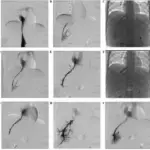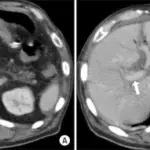Sinusoidal obstruction syndrome is the blockage of the very small (microscopic) veins in the liver.
What is the Pathology of Sinusoidal Obstruction Syndrome?
The pathology of sinusoidal obstruction syndrome is:
-Etiology: The cause of sinusoidal obstruction syndrome is the ingestion of pyrrolizidine alkaloids
-Genes involved: None.
-Pathogenesis: The sequence of events that lead to sinusoidal obstruction syndrome includes a toxic agent which damages sinusoidal endothelial cells, likely via depletion of glutathione and nitric oxide.
-Histology: The histology associated with sinusoidal obstruction syndrome shows acutely, hemorrhage into markedly dilated sinusoids with hepatocyte atrophy; sinusoids are denuded, though this may be difficult to see clearly. Later, some regions of the liver heal while others show collapse; constriction/obliteration of small central veins by subendothelial swelling/fibrosis can be seen.
How does Sinusoidal Obstruction Syndrome Present?
Patients with sinusoidal obstruction syndrome typically affect females present at the age range of 35-55. The symptoms, features, and clinical findings associated with sinusoidal obstruction syndrome include marked weight gain, tender hepatomegaly, ascites and jaundice, portal hypertension, and in rare cases cirrhosis.
How is Sinusoidal Obstruction Syndrome Diagnosed?
Sinusoidal obstruction syndrome is diagnosed using doppler and ultrasound.
How is Sinusoidal Obstruction Syndrome Treated?
Sinusoidal obstruction syndrome is treated with defibrotide sodium or mild diuretics.
What is the Prognosis of Sinusoidal Obstruction Syndrome?
The prognosis of sinusoidal obstruction syndrome is poor with an increased mortality rate.



